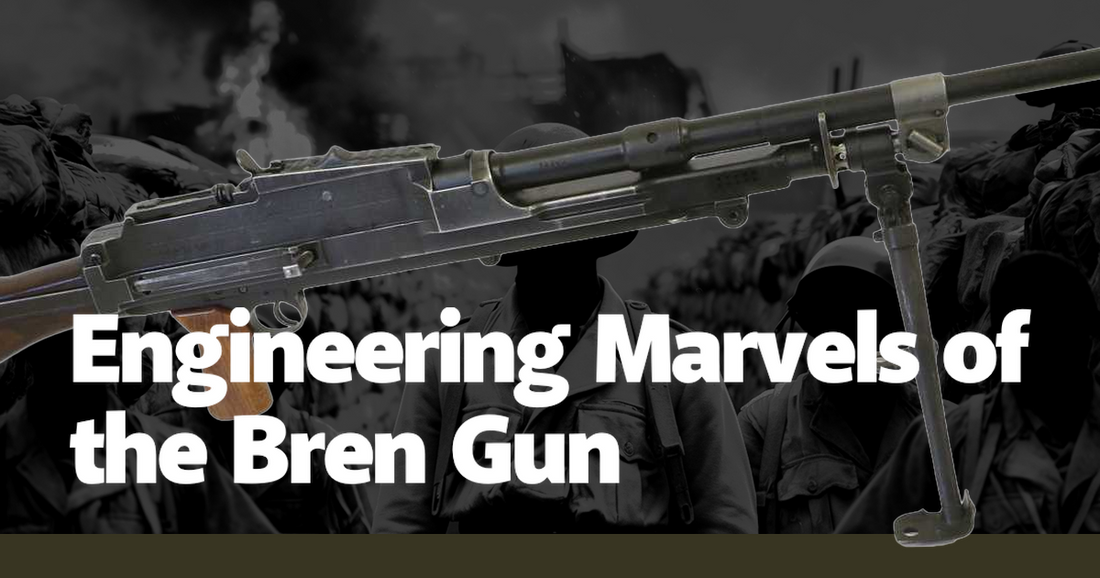The Bren Gun, a British light machine gun, stands as one of the most iconic firearms of the 20th century, a testament to engineering prowess and battlefield utility. Developed in the 1930s, the Bren Gun was the result of a collaboration between British and Czech engineers, who sought to create a weapon that combined accuracy, reliability, and ease of use. The origins of the Bren can be traced back to the Czechoslovakian ZB vz. 26, a weapon that impressed British military officials with its performance during trials. The British Royal Small Arms Factory in Enfield modified the design to suit their needs, resulting in the Bren Gun, named by combining "Brno" (the Czech city where the original was designed) and "Enfield."
One of the most notable features of the Bren Gun was its top-mounted curved magazine, which held 30 rounds. This design not only allowed for gravity-assisted feeding but also provided a distinctive silhouette that made the weapon instantly recognizable. The magazine's positioning also facilitated quick reloading, a crucial factor in the heat of battle. Soldiers could swiftly swap out an empty magazine for a full one, minimizing downtime and maintaining a steady rate of fire. The Bren's ability to sustain a high rate of fire while maintaining accuracy was a game-changer on the battlefield, providing infantry units with a significant tactical advantage.
The Bren Gun's reliability was another key factor in its success. Unlike many other light machine guns of the era, the Bren was known for its ability to function in harsh conditions, from the deserts of North Africa to the jungles of Southeast Asia. Its robust construction and meticulous engineering ensured that it could withstand the rigors of combat. Anecdotes from soldiers who used the Bren often highlight its dependability; in one instance, a British soldier recounted how his Bren continued to fire accurately even after being submerged in mud during the Battle of Normandy.
Accuracy was a hallmark of the Bren Gun, thanks to its precision-engineered barrel and bipod support. The weapon's barrel could be quickly changed when it became overheated, a feature that extended its operational life and maintained its accuracy during prolonged engagements. The bipod provided a stable firing platform, allowing gunners to lay down precise suppressive fire. This combination of accuracy and stability made the Bren an effective tool for both offensive and defensive operations, enabling troops to pin down enemy forces and support advances.
The Bren Gun's versatility was further demonstrated by its adaptability to various roles on the battlefield. It could be used as a light machine gun for infantry support, mounted on vehicles for mobile firepower, or even adapted for anti-aircraft use. This flexibility made the Bren an invaluable asset to British and Commonwealth forces throughout World War II and beyond. Its effectiveness was not limited to conventional warfare; during the Malayan Emergency, British forces used the Bren in counter-insurgency operations, where its reliability and firepower proved crucial in dense jungle terrain.
Training with the Bren Gun was an integral part of a soldier's preparation. The weapon's design emphasized ease of use, but mastering it still required practice and discipline. Soldiers were trained to disassemble and reassemble the Bren, ensuring they could maintain it in the field. Live-fire exercises helped them become proficient in its operation, learning to control its rate of fire and manage its recoil. These training programs were essential in maximizing the Bren's effectiveness, turning well-trained gunners into a formidable force on the battlefield.
The legacy of the Bren Gun extends beyond its service life, influencing the design of subsequent light machine guns. Its combination of accuracy, reliability, and versatility set a standard that future weapons would strive to meet. The Bren's impact can be seen in the design of the FN MAG and the L86A1 Light Support Weapon, both of which drew inspiration from the Bren's engineering principles. Even today, the Bren is remembered as a symbol of British ingenuity and military excellence, a firearm that played a crucial role in some of the most pivotal conflicts of the 20th century.
In conclusion, the Bren Gun remains a marvel of engineering, a weapon that exemplified the best qualities of light machine guns during its era. Its distinctive design, reliability in harsh conditions, and adaptability to various roles made it an indispensable tool for British and Commonwealth forces. The stories of soldiers who relied on the Bren underscore its significance, highlighting a weapon that was not only effective but also trusted by those who wielded it. As we reflect on the history of military technology, the Bren Gun stands out as a shining example of how thoughtful engineering can create a tool that shapes the course of history.

